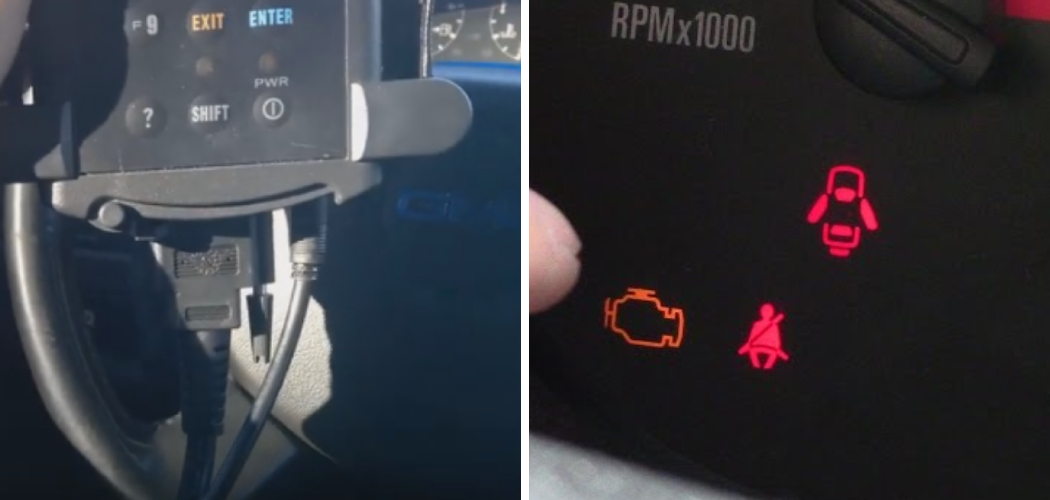In an age where technology reigns supreme, understanding the health of your vehicle has never been more crucial. For General Motors (GM) owners, the ability to diagnose issues efficiently can save both time and money.
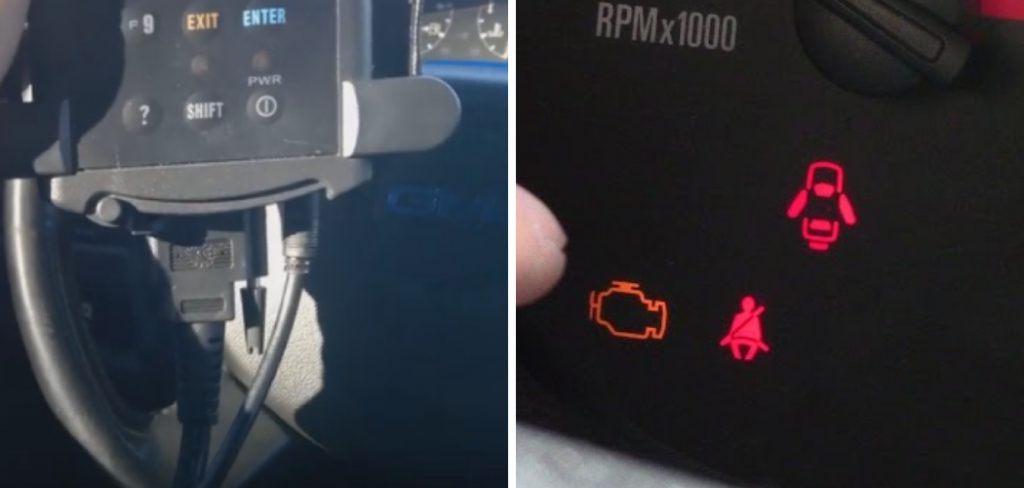
In this guide, we’ll illuminate how to read OBD2 codes without scanner GM, providing you with the skills necessary to identify potential problems. Being able to interpret what your car is communicating without specialized tools is an invaluable skill, offering autonomy and insight into your vehicle’s status, and we’re here to help you master this knowledge.
Understanding OBD2 Systems and GM Compatibility
A. Introduction to OBD2 and its standardized approach for reading codes
Onboard Diagnostics II (OBD2) systems are integrated into vehicles, serving as a standardized gateway for technicians and vehicle owners to monitor the car’s health and performance.
OBD2’s universal approach means data codes, typically related to emissions and engine performance, can be read via a common interface. This system flags any abnormalities or malfunctions with Diagnostic Trouble Codes (DTCs), which can be accessed in many instances without needing a professional scanning tool.
B. Compatibility of This Method with General Motors Vehicles
General Motors, one of the largest automotive manufacturers, has equipped most of its vehicles with OBD2 systems since 1996. While the method to read OBD2 codes without a scanner is broadly applicable, it is specifically compatible with many GM models up to the mid-2010s.
However, be aware that certain newer GM vehicles, especially those with more advanced technology, may have limitations or require an actual scanner to retrieve the codes effectively.
C. Importance of Using Caution and Interpreting Codes Correctly
Interpreting OBD2 codes without a scanner is a handy skill for GM vehicle owners. Still, it carries the responsibility of accuracy and safety. Caution must be taken when accessing the diagnostic mode and deciphering the flashed codes.
Incorrect interpretation can lead to misdiagnosing vehicle issues, potentially leading to further complications. It’s essential to cross-reference codes with reliable sources and consider seeking professional advice to ensure that problems are accurately identified and resolved.
How to Read OBD2 Codes Without Scanner GM: Two Methods
A. Method 1: Using the Odometer Reset Button
Identifying compatible GM models and year ranges
GM vehicles from the mid-1990s up to around the mid-2010s often support the ability to access OBD2 codes through the odometer reset button. This method mainly applies to cars and trucks that do not have a fully digital instrument cluster.
Step-by-step instructions for accessing and displaying codes
- Ensure your vehicle is in the park (or neutral if manual) and the ignition is off.
- Hold down the odometer reset button.
- While holding the button, turn the ignition to the “On” position b,t do not start the engine.
- Continue to hold the button until the dashboard lights up and the display shows the car’s mileage.
- Release the button and observe; the instrument cluster will enter a diagnostic mode and flash the trouble codes, one at a time.
Interpreting different code formats
In the diagnostic mode, trouble codes usually appear with a letter followed by four numbers (e.g., P0301). The letter indicates the system related to the issue:
- P for Powertrain (engine and transmission) problems,
- B for Body (such as seat belts and airbags),
- C for Chassis (systems like anti-lock brakes),
- U for User network (wiring and data sharing among systems).
B. Method 2: Using a Paperclip or Jumper Wire
Identifying compatible GM models and year ranges
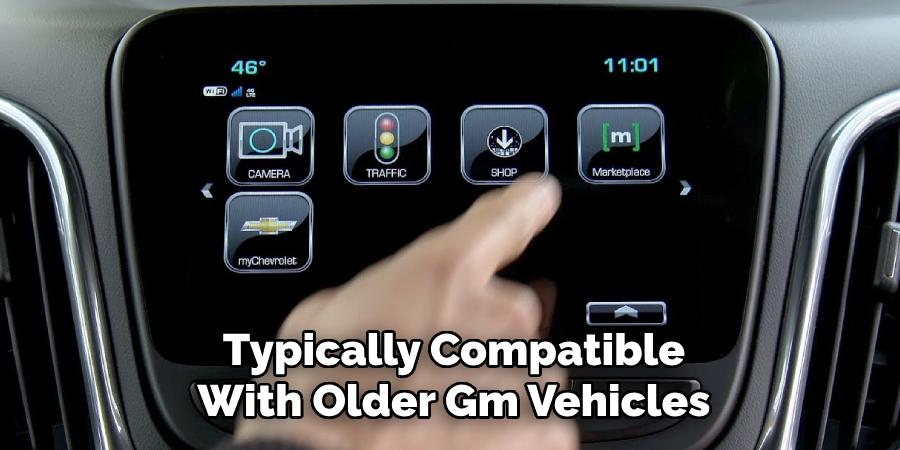
This approach is typically compatible with older GM vehicles, especially those manufactured before OBD2 readers became widely accessible. Commonly applicable to models from the late 1980s to the mid-1990s, this method can verify trouble codes from a simpler era of vehicle diagnostics.
Locating the diagnostic connector under the dashboard
Find the diagnostic connector, typically located under the dashboard on the driver’s side. It is a rectangular port with multiple pin slots, often uncovered and easily accessible.
Creating a connection between specific terminals with a paperclip or wire
A metal paperclip or a small jumper wire can be used to retrieve codes manually. Insert one end of the jumper into the terminal slot labeled “A” and the other end into the terminal slot labeled “B”. These are generally the two upper-right terminals on a 12-pin OBD1 GM connector.
Observing the Check Engine Light flashes for code interpretation
After forming the connection:
- Turn the ignition to the “On” position without starting the engine.
- Observe the Check Engine light. It will begin to flash codes in a sequence of short and long pulses.
- Count the number of flashes, which will indicate the trouble code numbers. For example, a flash and pause would indicate code 12, and then two quick flashes.
- Write down the sequences for each code and interpret them using a reference resource specific to GM’s OBD1 codes.
Limitations and Cautions
A. Not All GM Models or Codes Are Accessible Through These Methods
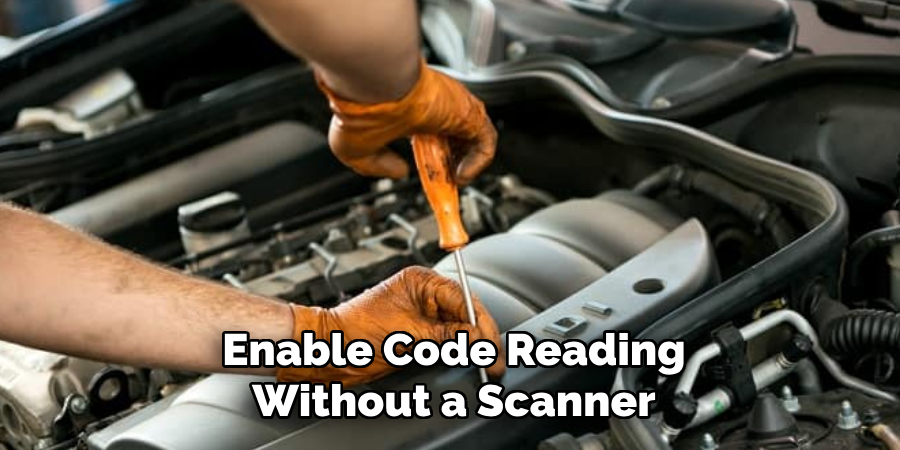
While the above methods enable code reading without a scanner for many General Motors vehicles, it’s important to acknowledge their limitations. Not all GM models, particularly newer or more technologically sophisticated ones, are compatible with these techniques.
Additionally, there may be instances where certain codes, particularly those that are manufacturer-specific or related to new vehicle features, cannot be accessed through these do-it-yourself methods.
B. Inability to Retrieve Detailed Information or Perform Live Data Analysis
Using the odometer or paperclip methods for retrieving OBD2 codes provides a basic diagnostic service that lacks depth. Unlike professional scanners, these methods cannot furnish detailed information or real-time data analysis, which are often crucial for comprehensive diagnostics and troubleshooting. For nuanced vehicle issues or when precise data is required to guide repairs, the use of professional diagnostic equipment may be necessary.
C. Importance of Accurate Code Interpretation and Referencing Resources
Accurately interpreting OBD2 codes is critical in diagnosing and resolving vehicle issues effectively. An incorrect interpretation can lead to inappropriate repairs, further vehicle damage, or unnecessary costs.

Vehicle owners should always cross-reference trouble codes with trustworthy resources or databases that are specific to GM vehicles and their corresponding model years. When in doubt or when dealing with complex issues, consulting a qualified technician is advised to ensure proper diagnosis and repair.
That’s it! You’ve now learned how to read OBD2 codes without scanner GM using two different methods. Remember to exercise caution and always double-check your code interpretations with reliable sources to ensure accurate identification and resolution of vehicle issues. We hope this guide has been helpful, and happy diagnosing!
Alternative Solutions and Additional Resources
A. Benefits of Using an OBD2 Scanner for Deeper Diagnostics
Professional OBD2 scanners present numerous advantages for detailed vehicle diagnostics. By interfacing directly with the vehicle’s onboard computer, these devices can delve into advanced data streams, providing real-time analysis of engine operation, fuel efficiency, and emissions systems.
They often feature capabilities to reset warning lights, program new vehicle parts, and monitor live data for pinpoint accuracy in troubleshooting. The depth of information available through these scanners is far superior to the basic code readings of the odometer reset button or paperclip methods.
B. Mobile Apps and Smartphone Adapters Offering Affordable Scan Functionality
Today, advancements in smartphone technology have paved the way for affordable vehicle diagnostics through mobile apps paired with Bluetooth or Wi-Fi-enabled OBD2 adapters. These compact devices plug into the OBD2 port and communicate with smartphones, turning them into versatile scan tools.
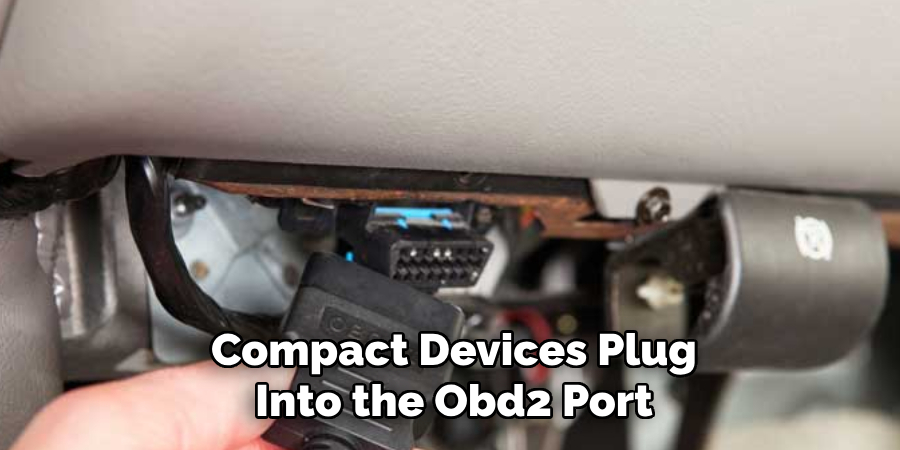
Apps such as Torque or CarScanner offer a range of features like reading and clearing codes, live data feeds, and even customizing dashboards. They make vehicle diagnostics accessible to a broader base of drivers, providing a cost-effective and user-friendly alternative to traditional scanners.
C. Online Resources for GM-specific Code Lookup and Troubleshooting
For GM vehicle owners, various online platforms exist to assist with code lookup and troubleshooting. Websites like OBD-Codes.com and TroubleCodes.net provide expansive databases tailored to GM vehicles, offering detailed definitions, probable causes, and repair procedures for specific OBD2 codes.
Additionally, GM-specific forums and automotive DIY blogs serve as reservoirs of wisdom, filled with discussions, expert advice, and shared experiences from a community of enthusiasts and technicians that can prove invaluable for both novice and seasoned mechanics.
In-Depth Code Interpretation
A. Understanding Common GM OBD2 Code Classifications
OBD2 codes, also known as Diagnostic Trouble Codes (DTCs), are alphanumeric codes that a vehicle’s onboard diagnostics system uses to alert to specific issues. In the case of General Motors (GM) vehicles, understanding the distinctions between generic and manufacturer-specific codes is crucial for accurate diagnostics.
Generic codes, starting with ‘P0’, are standardized for all car makers and typically refer to powertrain issues, including engine, transmission, and associated accessories. On the other hand, manufacturer-specific codes begin with ‘P1’, ‘B’, or ‘U’ and address problems unique to GM vehicles.

For instance, ‘B’ codes pertain to body systems like airbags and power seats, while ‘U’ codes relate to network and vehicle integration, such as issues with the communication bus. Recognizing these categories helps home in on the system affected and narrows down potential causes.
B. Decoding Specific Code Examples for Common GM Issues
Frequent mechanical issues such as oxygen sensor malfunctions, misfires, and emission problems generate their respective OBD2 codes that help diagnose the root cause of the problem. For example, the code P0131 is a generic DTC indicating “O2 Sensor Circuit Low Voltage (Bank 1, Sensor 1).” This suggests a potential fault in the oxygen sensor or the wiring related to it, affecting the fuel-air ratio and causing the engine to run lean or rich.
Misfires are another common issue often indicated by codes such as P0300, which signifies “Random/Multiple Cylinder Misfire Detected.” This general misfire can be attributed to various faults, such as spark plug degradation, ignition system defects, or even poor fuel quality.
Emissions issues might trigger codes like P0420, “Catalyst System Efficiency Below Threshold (Bank 1).” It points towards inefficiencies in the catalytic converter’s ability to reduce exhaust pollutants, possibly due to an internal failure or an upstream issue such as faulty oxygen sensors.
Advanced Troubleshooting Tips
A. Addressing Persistent Check Engine Light Issues
Persistent Check Engine Light (CEL) issues can be frustrating for vehicle owners. While interpreting OBD2 codes is the first step, identifying consistent problem areas requires a more in-depth understanding. For GM models, researching code solutions specifically tailored to the vehicle’s make and model can provide insight into recurring issues.
Often, seemingly unrelated trouble codes can point to a common source problem, indicating a systemic issue rather than isolated failures. Delving into technical service bulletins and manufacturer resources can guide owners to the root cause of a persistent CEL.
B. Utilizing Online Forums and Communities for GM Owners
Online forums and communities are invaluable resources for GM owners tackling diagnostic trouble codes. Sharing your code information and the vehicle’s symptoms in these specialized groups can garner advice from experienced enthusiasts and mechanics who have faced similar challenges.
Interacting with these communities allows access to a wealth of knowledge, tips on part sourcing, and step-by-step repair guidance. Furthermore, the collective wisdom of such groups often extends beyond the data provided by a scan tool, offering practical solutions and workarounds that aren’t found in official repair manuals.
C. When to Consult a Qualified Mechanic or Dealership
Certain scenarios necessitate a qualified mechanic’s expertise or a dealership trip. Complex repairs requiring specialized tools or in-depth knowledge of GM systems are best left to professionals. Advanced diagnostics beyond basic code reading call for expert interpretation, especially when multiple systems are involved, or intermittent issues elude straightforward diagnosis.
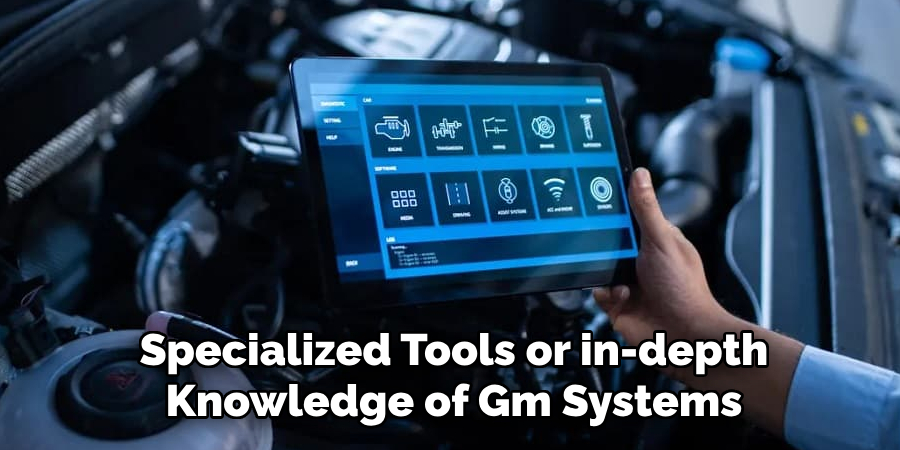
Additionally, warranty concerns should guide owners to authorized service centers to avoid unintentionally voiding their coverage. A trusted mechanic’s guidance can save time and money and prevent exacerbating the problem with DIY repairs when dealing with intricate vehicle issues.
Staying Informed and Responsible
A. Importance of Regular Vehicle Maintenance to Prevent Issues
Adhering to the recommended service intervals is a pivotal aspect of vehicle maintenance that can preempt many common issues. With the implementation of a consistent maintenance routine, car owners can ensure the longevity and performance of their GM vehicles.
This includes using quality parts that comply with OEM standards, which further guarantees that the integrity of the vehicle’s various systems is maintained. Proactive replacement of wear-prone components, like belts and filters, alongside regular oil changes, plays a vital role in preserving engine health and efficiency.
B. Staying Updated on GM Recalls and Technical Service Bulletins (TSBs)
Maintaining an up-to-date awareness of GM recalls and TSBs is essential for ensuring vehicle safety and performance. Recalls are issued for critical safety defects and should be addressed promptly to avoid potential hazards.
Additionally, TSBs, which often detail common problems and their solutions, can be a crucial indicator of known issues with your GM model. Owners should regularly check with the National Highway Traffic Safety Administration (NHTSA) or GM for new bulletins and recalls. Taking swift action when updates or necessary updates or repairs help are necessary helps to safeguard against future mechanical failures.
C. Encouraging Safe and Responsible Driving Practices
Safe and responsible driving extends beyond adherence to traffic laws. Regular checks of tire pressure and fluid levels, including engine oil, brake fluid, and coolant, can prevent accidents and breakdowns. Ensuring that lights and signals are operational enhances visibility and communication with other drivers.

Additionally, being mindful of the vehicle’s load capacity and avoiding aggressive driving behaviors contribute to vehicle longevity and safety on the road. These practices reduce the risk of incidents and contribute to better fuel efficiency and reduced wear and tear on the vehicle.
Frequently Asked Questions
Q1: What Does It Mean When The Check Engine Light (CEL) Turns On, but The Car Seems to Run Fine?
A1: The CEL can be triggered by a range of issues, some of which may not cause noticeable driving problems initially. It’s important to conduct a diagnostic scan to retrieve the trouble codes, which will help pinpoint the underlying issue. Ignoring the CEL can lead to more serious problems over time.
Q2: Can I Use an OBD2 Scanner for Any GM Vehicle, or Do I Need a Specific Type?
A2: OBD2 scanners are standardized tools and should be compatible with all GM vehicles manufactured from 1996 onwards. However, some advanced scanners provide more detailed data and may offer additional features suited to specific models.
Q3: Should I Attempt to Fix a Problem Indicated by A DTC Myself, or Is It Better to Take My Car to A Mechanic?
A3: This depends on your level of expertise and the complexity of the issue. Simple fixes like replacing a sensor or spark plugs can typically be done at home with basic tools. However, if the problem involves complex systems or requires special equipment, it’s better to consult with a professional mechanic.
Q4: How Often Should I Check for Recalls or TSBs for My GM Vehicle?
A4: It’s a good practice to check for updates whenever you schedule regular maintenance for your vehicle or at least twice a year. Keeping informed of recalls and TSBs ensures that you address any potential issues in a timely manner.
Q5: How Can I Find out If a Part Is Compliant with OEM Standards?
A5: You should look for packaging information indicating OEM compliance or check the manufacturer’s website for specifications. Reputable auto parts stores and dealerships can also provide guidance on purchasing OEM-standard parts for your vehicle.
Conclusion
To effectively manage and maintain the health of your GM vehicle, understanding OBD2 codes is paramount. The journey we’ve outlined, from basic code interpretation to more advanced troubleshooting, equips GM owners with the necessary knowledge.
While learning how to read OBD2 codes without scanner GM may seem daunting, the resources and guides provided serve as a foundation for confident vehicle diagnosis and maintenance.
Emphasizing responsible ownership through informed decision-making and staying abreast of maintenance and safety updates will ensure that you enjoy the full benefits of a well-cared-for vehicle. With these tools and a proactive approach, you can navigate the intricacies of your car’s health, ensuring it remains reliable for the road ahead.

